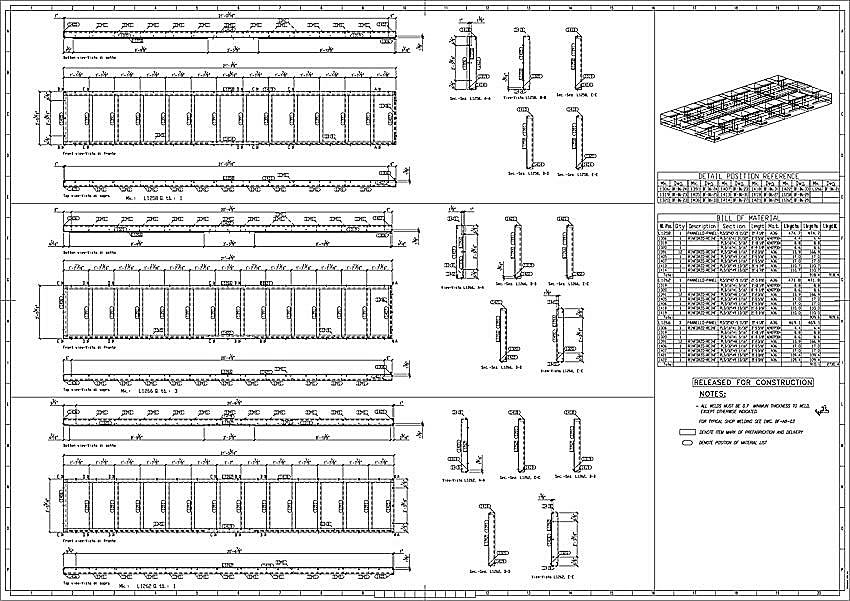Structural Drawing Standards Symbols And Shop Drawings
We use cookies to ensure we give you the best experience on our website. You can find out about our cookies and how to disable cookies in our Privacy Policy. If you continue to use this website without disabling cookies, we will assume you are happy to receive them. Close.

Shop drawings

Shop drawings might be prepared by contractors, subcontractors, suppliers, manufacturers or fabricators. They generally relate to pre-fabricated components, showing how they should be manufactured or installed. They take design intent drawings and specifications prepared by the project design team and develop them to show in detail how the component will actually be manufactured, fabricated, assembled or installed.
Shop drawings might be prepared for components such as structural steelwork, reinforcement, lifts, building services equipment, appliances, ductwork, piping, plumbing, windows, cabinets, electrical and data layouts, fire protection and so on.
They may be reviewed by the project design team prior to fabrication to verify that they comply with design drawings and specifications and to ensure that different packages of work and components are properly coordinated. This means that they need to contain relevant information to enable this to be done, which might include the provision of samples for approval. However, this does not relieve the originator of the drawings from responsibility for their correct preparation.
Shop drawings may also be used to check installation on site. Suppliers may wish to visit the site before, or during the preparation of shop drawings to verify key dimensions are accurate, particularly on refurbishment or renovation projects.
Where shop drawings vary from design drawings, these variations should be highlighted on the shop drawings and brought to the attention of the design team. This is particularly important to ensure proper co-ordination on site, as fabricators are likely only to refer to the shop drawings, and not the design drawings.
Procedures may be in place for the electronic handling of drawings for comment, review and co-ordination. Where digital drawings are required, file formats, naming and layering conventions may have to be adhered to. Increasingly, building information modelling is used as a means of managing project information, co-ordinating the design and detecting clashes. This can be useful to suppliers in providing clear information upon which shop drawings can be based, and allowing the shop drawings themselves to be re-incorporated back into the building information model, eliminating time-consuming manual practices and minimising errors.
PAS 1192-2:2013 Specification for information management for the capital/delivery phase of construction projects using building information modelling (now replaced by BS EN ISO 19650) states that, 'There shall be a 'change of ownership' procedure for the information and objects that specialist sub-contractors introduce to replace the original designers' intent such that the resulting graphical models can be used for fabrication, manufacture and installation… This change of ownership should be fully understood, specialist teams do not alter the models produced by the professional designers: they build new models defining the virtual construction model (VCM).'
Some suppliers may not yet have the capability of producing BIM information, and this may prove a barrier to winning work.
Increasingly, the preparation of shop drawings is outsourced where the supplier does not have the appropriate skills, software, hardware or resources necessary, or where they may be able to obtain lower rates or faster turnaround. However, this may not properly exploit the expertise of the supplier and places responsibility for preparing important design information with an organisation that is not contractually responsible for it and may not have the detailed knowledge necessary. The supplier should carefully check any shop drawings that are outsourced in this way.
[edit] Related articles on Designing Buildings Wiki
- As-built drawings and record drawings.
- Assembly drawing.
- Building information modelling.
- Detail drawing.
- Component drawing.
- Concept drawing.
- Design drawings.
- Drawings.
- Electrical drawing.
- General arrangement drawing.
- Installation drawings.
- Notation and units on drawings and documents..
- Plumbing drawing.
- Production drawing.
- Production information.
- Projections.
- Scale drawing.
- Section drawing.
- Suppliers.
- Symbols on architectural drawings.
- Technical drawing.
- Technical drawing pen sizes.
- Working drawings.
Structural Drawing Standards Symbols And Shop Drawings
Source: https://www.designingbuildings.co.uk/wiki/Shop_drawings
Posted by: davisbrounally.blogspot.com

0 Response to "Structural Drawing Standards Symbols And Shop Drawings"
Post a Comment